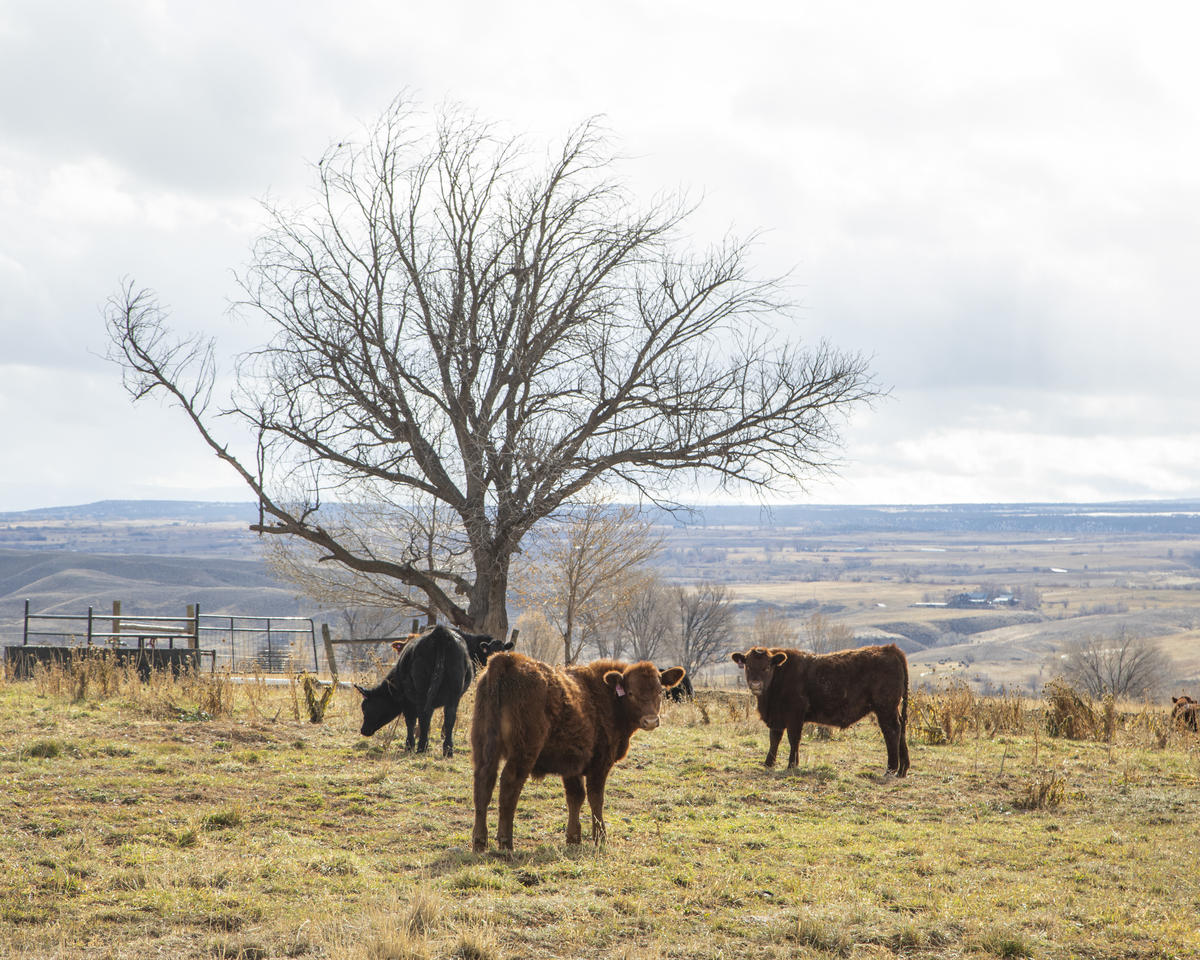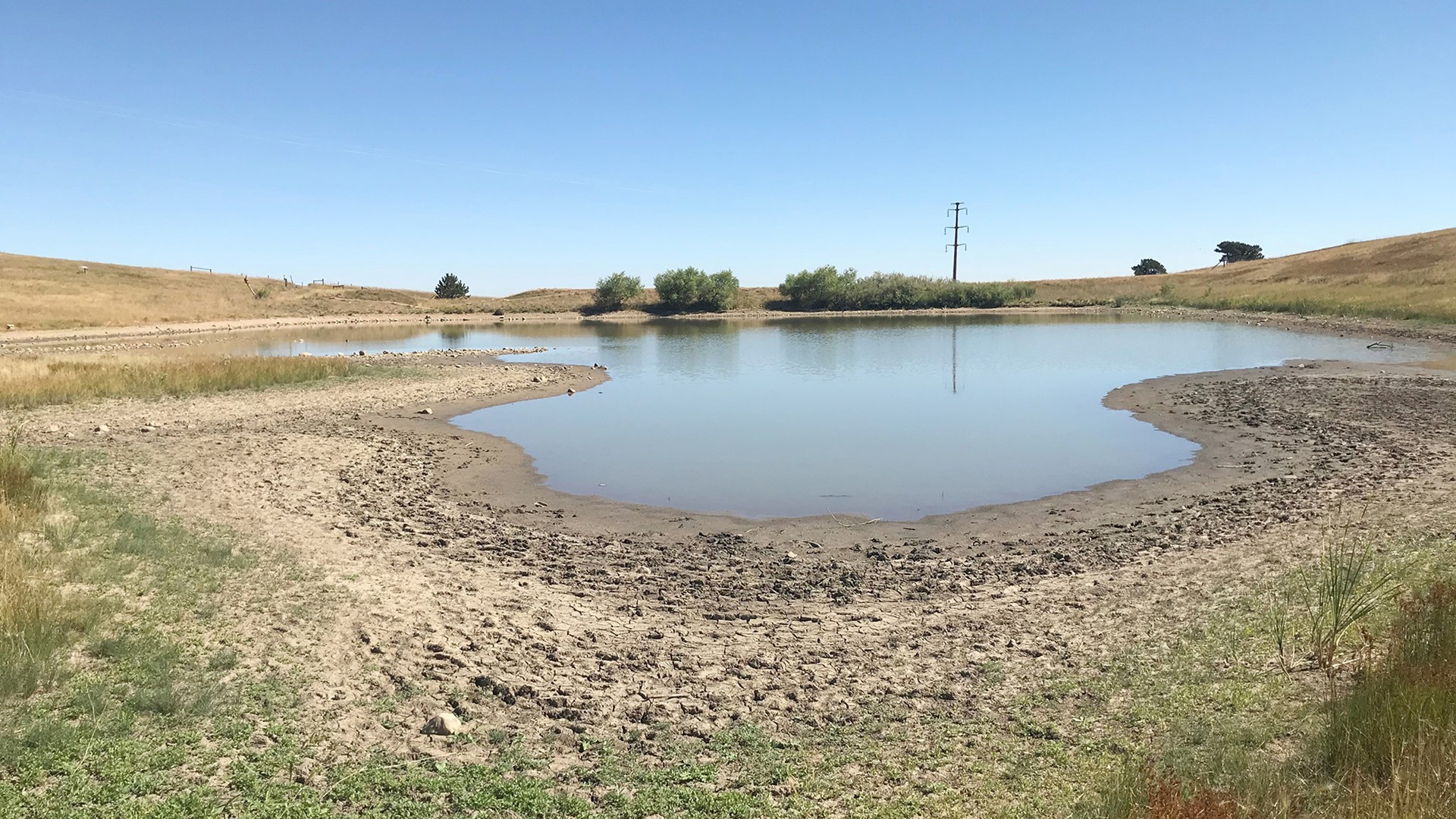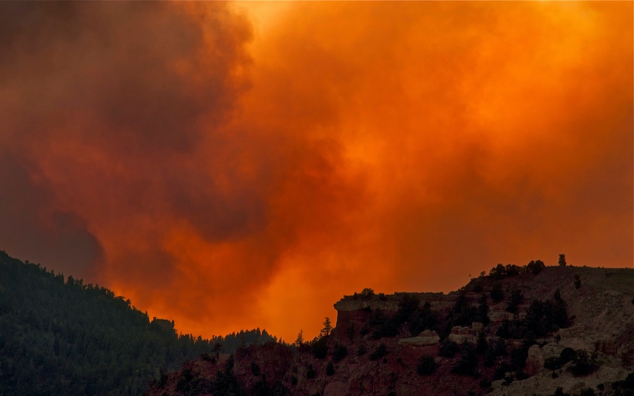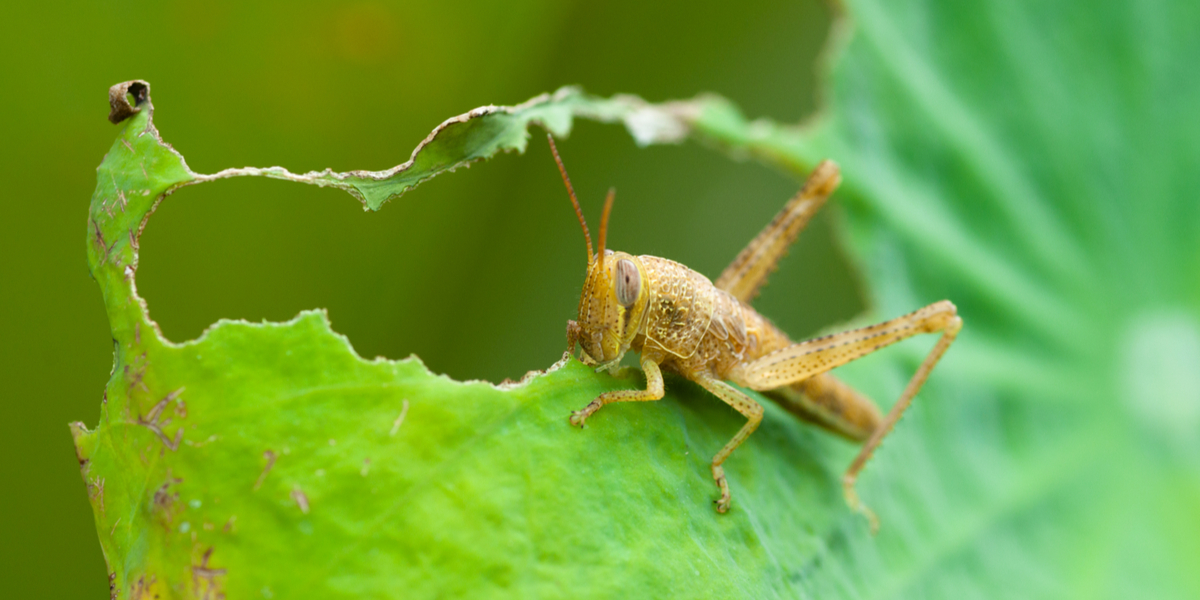
Colorado Drought Stories
An interactive web report of agriculture adaptation in action
The New Normal
What exactly does that mean? Ask a Colorado farmer and you are likely to hear a common word: dry.
Our agriculture communities bear the brunt of our drying landscapes. Deeply connected to ecosystem conditions and the lasting impacts of past droughts, Colorado producers are on the front lines of drought and a changing climate.
On the heels of an intense 2018 drought and in the midst of the COVID-19 pandemic, 2020’s drought disaster hit agricultural producers hardest. And climate outlooks are clear: these conditions are expected to continue well into spring. Should hot and dry conditions persist into 2021, more economic sectors and urban regions will feel the arid squeeze of prolonged, multi-year drought.
Droughts of the past are not the same as droughts of the future.
Multiple hazards in one year (such as drought, wildfire, disease, or flood) certainly take deep economic and ecological tolls on landscape-based economies such as agriculture, tourism, and recreation. Coloradans are grappling with increasing pressure to recover, respond, and prepare for multiple hazards at once, which can overwhelm even the largest or well-funded communities.
"Colorado has experienced four severe droughts since 2000, but the trend has intensified with the drought of 2018 barely lifting before 2020 brought searing temperatures and dry weather again." - Jerd Smith, Fresh Water News
We know Colorado faces more frequent and intense hazards . You can take a deep dive and learn how drought affects Colorado's agriculture industry here .
History of Colorado drought intensity (D0-D4) and percent coverage // Source: US Drought Monitor
2020 Conditions In Review
Water Year 2020 was the third driest water year on record, trailing only 2002 (1st) and 2018 (2nd). The 2020 drought demonstrated how dry years accumulate soil moisture deficits across the landscape. With poor soil conditions, even historically average winter snowpack years may not translate into average spring runoff. Major drivers of the severe drought in 2020 included absent monsoon seasons, accruing soil moisture deficits, record high temperatures, and near record evaporative vegetation demands (high winds and hot temperatures).
A running loop of the 2020 U.S. Drought Monitor below shows steady declines in conditions throughout the spring and summer, with Severe (D2) and Extreme (D3) conditions originating in the southwest and southeast, and then expanding up the eastern plains and western slope. Extreme (D3) drought conditions first emerged on May 5th, initially covering 11% of the state. By July 14th, 37% of the state was under D3-conditions and 54% by September 9th. Exceptional (D4) conditions emerged in late August and covered over a quarter of the state by December 2020.
Animation of US Drought Monitor maps from 2020 // Source: Colorado Climate Center
The impacts of drought don’t stop at the drought monitor.
Many producers report more intense impacts than are currently reflected in monitoring data. Below, in our "Virtual Drought Tour", you can hear first hand accounts of drought pressures, conditions, and incredible resilience from our ambassadors of adaptation - Colorado farmers, ranchers, and reporters across the state.
Virtual Drought Tour

Adaptive management on Sakata Farms
Adaptive management on Sakata Farms. Click to expand.
Explore the difference between two fields on Sakata Farms this drought season.

Largest wildfires in Colorado's history
Largest wildfires in Colorado's history. Click to expand.
The state's three largest-ever fires burned this summer. Story by Andy Stein.

Extended drought
Extended drought. Click to expand.
A first-generation ranch manager writes "we need to change the semantics and management around drought. Drought tends to carry a notion of impermanence. We are essentially in our third year of drought, which, feels more permanent and requires a different mindset and management of our beautiful resources." Story by Michael Elizabeth Sakas.

Colorado farmers and ranchers on the front line of climate change
Colorado farmers and ranchers on the front line of climate change. Click to expand.
The last three monsoon seasons have been the worst three on record in western Colorado. Story by Michael Elizabeth Sakas.

Adapting to climate and market changes
Adapting to climate and market changes. Click to expand.
Ranchers in Southwest Colorado raise cattle adapted to the conditions of the area and take advantage of direct-to-consumer local meat demands. Story by Emily Hayes.

Western slope peach crop hit by devastating freeze
Western slope peach crop hit by devastating freeze. Click to expand.
A deep freeze in April led to massive crop losses for Colorado's fruit growers on the western slope. Story by Nancy Lofholm.

Drought impacts western slope producers
Drought impacts western slope producers. Click to expand.
Radio station KVNF discusses the impacts of continuous hot and dry weather in Western Colorado with Reagan Waskom, Director, Colorado Water Institute, Colorado State University, Harrison Topp, Topp Fruits, Kate Greenberg, Colorado Commissioner of Agriculture, and rancher, Cynthia Houseweart, Princess Beef. Click to listen to the radio story by Kori Stanton.

Challenging to produce a crop
Challenging to produce a crop. Click to expand.
On the Eastern plains hot dry winds and lack of average moisture made it hard to produce a crop. When farmers don't make money, it impacts the local economy as well. Video by Channel 7 News.

Water storage is critical
Water storage is critical. Click to expand.
Ponds in residential areas are drying but Colorado's important storage reservoirs on the Front Range were in good shape in 2020, thanks to previous season's average snowpack. Story by Cory Reppenhangen of 9 News.

Water levels well below average in Colorado rivers
Water levels well below average in Colorado rivers. Click to expand.
Rivers flows were low this year all over Colorado and surrounding area. Inflow to Lake Powell was 11% of average in September. Video story by 9news.com.

South Platte River strained by little rain and high temperatures
South Platte River strained by little rain and high temperatures. Click to expand.
Even with above average snowpack, flows on the South Platte River in the Eastern Plains were low due to high temperatures and lack of spring rain which increased demand on the river. Video story by 9news.com.

Drought conditions continue to grip all of colorado
Drought conditions continue to grip all of colorado. Click to expand.
The lack of precipitation and unrelenting heat is a bad combination for agricultural producers and creates conditions ripe for wildfire. Story by Alison Borden.

Economic impact of demand management
Economic impact of demand management. Click to expand.
Demand management programs could pay farmers to use less water in hopes of refilling Lake Powell. Story by Heather Sackett.

Southern Colorado farmers adapt through Coronavirus and drought
Southern Colorado farmers adapt through Coronavirus and drought. Click to expand.
Farmers had to adapt to two challenges at once: Drought and a pandemic. They adapted by moving cattle and hiring fewer workers to create more space in farm housing. Story by Elan Rivera.

Switching to drought resistant varieties
Switching to drought resistant varieties. Click to expand.
Miguel and Marcos Diaz have switched to drought resistant varieties of barley grain and have cut back on acreage to reduce water use. Watch our interview with Miguel and Marcos.

Diversity creates resilience
Diversity creates resilience. Click to expand.
Introducing livestock and cover crops into their crop rotation decreased water use and has made Rockey Farms more resilient. Watch our interview with Sheldon Rockey.

Cattle ranchers face a multiple challenges during drought
Cattle ranchers face a multiple challenges during drought. Click to expand.
Cattle ranchers must find water and feed for cattle during droughts and decide how many calves to sell. Click here to watch full video.

Consumers support local meat
Consumers support local meat. Click to expand.
Demand for direct-to-consumer meats increased during the pandemic, creating opportunities to develop new income streams for the future. Story by Emily Hayes.

Flames at orchards amid drought conditions
Flames at orchards amid drought conditions. Click to expand.
Star Harvey, KREX 5 News, took a trip to Kokopelli Farms to find out how drought conditions are directly impacting local growers.

The 4H livestock show must go on
The 4H livestock show must go on. Click to expand.
Mesa county's containment of COVID-19 and physical-distancing protocols allowed for an in-person livestock show which proved to be uplifting in a time of uncertainty for the county's 4H participants. Story by Stina Sieg.

Farmers and ranchers already experience climate change
Farmers and ranchers already experience climate change. Click to expand.
Heatwaves, insect infestation, extreme precipitation, and drought are just a few ways climate change is already impacting the livelihoods of farmers and ranchers. Story by Michael Elizabeth Sakas.

Drought expected to worsen this winter
Drought expected to worsen this winter. Click to expand.
The National Weather Service predicts La Niña conditions for Colorado this year. This means equal chances of above-average or below-average snowfall for the northern part of the state but southern part of the state is predicted to have a drier-than-average weather. Story by Henry Fountain.

Drought and forest health impacts
Drought and forest health impacts . Click to expand.
Mike Lester, Director and State Forester for the Colorado State Forest Service walks through the many ways that drought and fire stress our state forests and water supply. Click here to watch full video.

Groundwater management in the San Luis Valley
Groundwater management in the San Luis Valley. Click to expand.
Tyler Michell is constantly innovating to improve soil health and slow aquifer depletion. Click here to watch full video.

Coronavirus outbreaks hit restaurants and rural agriculture
Coronavirus outbreaks hit restaurants and rural agriculture. Click to expand.
At the beginning of the pandemic, as customers flooded grocery stores, there was a surge in demand for San Luis Valley potatoes but there were also four coronavirus outbreaks in the valley's potato warehouses. Story by Lindsay Fendt.

Dryland farmers suffered huge losses
Dryland farmers suffered huge losses. Click to expand.
Drought tolerant crops such a wheat and milo that are grown in Eastern Colorado with no supplemental irrigation suffered huge losses. And the lack of precipitation mean no opportunity to plant a new crop in the fall. Story by Chase Woodruff.

High-temperature, low-soil-moisture trend
High-temperature, low-soil-moisture trend. Click to expand.
Climatologists warn that the trend seen throughout the Colorado River Basin where high temperatures and low soil moisture wiped out healthy snowpack levels is likely to become more normal in the future. Story by Lindsay Fendt.

Drought and virus impacts on small towns
Drought and virus impacts on small towns . Click to expand.
The year 2020 brought multiple compounding challenges. The economies of small towns reliant on tourism and agriculture were hit by the coronavirus pandemic and drought conditions prime for wild fires. Story by Judy Fahys.

"No easy solution"
"No easy solution". Click to expand.
Climate-caused water-supply issues are leading mountain communities with junior water rights to consider new supply alternatives that they may not be able to afford. Story by Catherine Lutz.

Voters support water conservation
Voters support water conservation. Click to expand.
More than 70% of voters on the Western Slope voted "yes" to increase property taxes with measure 7A. The money will be used for fighting to keep water on the Western Slope, protecting water supplies for Western Slope farmers and ranchers; protecting drinking water for Western Slope communities; and protecting fish, wildlife and recreation. Story by Heather Sackett.

More accurate data coming to the Four Corners
More accurate data coming to the Four Corners. Click to expand.
A new permanent weather station will be installed on Southern Ute tribal lands will bring more information about weather hazards to an areas previously considered a blind spot when it comes to weather and radar modeling in the region. Story by Johnathan Romeo.

Exceptionally high temperatures
Exceptionally high temperatures. Click to expand.
The year 2020 gave Denver a new record: 74 days of 90 degree temperatures. The average number of 90-degree days is 31 and the most recent record of 73 days was set in 2012. Post by the National Weather Service - Boulder.

Dust storms take hold
Dust storms take hold. Click to expand.
Dust storms have become more common and intense in the last 20 years and this year was no exception. Dust storms remove soil nutrients and reduce agricultural productivity while creating health hazards for humans and livestock. Story by Brooke Gilmore.

Eastern Plains battling hot winds
Eastern Plains battling hot winds. Click to expand.
Some of the most extreme drought conditions occurred on Colorado's Eastern Plains. Winds blew 6-10 mph faster than normal for much of the summer. Story by Andy Stein.

Colorado farmers contend with shifting markets due to COVID-19
Colorado farmers contend with shifting markets due to COVID-19. Click to expand.
Agriculture is the major economic driver in some CO counties and was deemed an essential business under the state's stay-at-home-order. Farmers had to find new buyers for products as the market shifted from wholesale to grocery stores. Story by Elena Rivera.

How to save the Colorado River
How to save the Colorado River. Click to expand.
As the West's population grows and drought cycles become more intense, ranchers are experimenting with ways to conserve water while continuing to grow fertile pastures. Story by Jerd Smith.

Deepest drought arrives in Colorado
Deepest drought arrives in Colorado. Click to expand.
Large fires in Colorado this summer are associated with intense drought conditions experienced across the state. Story by Matt Meister.

Drought and fire impact on our watersheds
Drought and fire impact on our watersheds. Click to expand.
Fires impact timing and quality of spring runoff. Less vegetation in burned areas can result in faster and earlier runoff and increased erosion of soil and fire retardant decreases water quality. Story by Bill Banks.

Colorado reservoirs down 25 percent as drought persists
Colorado reservoirs down 25 percent as drought persists. Click to expand.
Exceptional hot and dry conditions, including the hottest August on record in Colorado, contributed to the draw down of reservoirs. The snow storm Colorado saw on Sept. 8-9 was helpful but didn't ultimately make a big difference in drought conditions. Story by Sarah Kuta.

Selling cows is financially and emotionally difficult
Selling cows is financially and emotionally difficult. Click to expand.
The drought means reduced forage for livestock on unirrigated Western Slope rangelands, which can leave ranchers facing costly choices of buying supplemental hay, moving animals to another area or state or reducing their herd sizes. Story by Dennis Webb.

The high cost of wildfires
The high cost of wildfires. Click to expand.
The cost of fire suppression in Colorado surpassed $200 million in 2020 which does not include in the cost of local volunteer fire departments, victims of wildfire, or costs associated with animal care. Story by Alex O'Brien.
:format(webp):no_upscale()/cdn.vox-cdn.com/uploads/chorus_asset/file/21981415/merlin_2837634.jpg)
Preserving agricultural water rights
Preserving agricultural water rights. Click to expand.
As droughts become more persistent and urban growth across the Mountain West continues to skyrocket, ag communities are worried about losing their water to far away cities. Some farmers are finding innovative ways to share water and remain in business. Story by Sofia Jeremias.

Poor-to-very-poor conditions
Poor-to-very-poor conditions. Click to expand.
Due to dryness and heat, 44% of Colorado's pastures and rangelands were rated poor-to-very-poor condition by the USDA National Agriculture Statistics Service. Story by Michael Nepveux.

Farmers and ranchers rely on water
Farmers and ranchers rely on water. Click to expand.
Over 50% of water consumed in the Colorado River Basin goes to crops such as alfalfa and hay used to feed livestock. Some Colorado ranchers support strategies like improved irrigation systems and rebuilding riparian habitat. Story by Troy Farah.

Drought can lead to (more) debt
Drought can lead to (more) debt. Click to expand.
Having enough hay is often the deciding factor between a profitable year and taking on more debt. Many producers are short on hay this year due to drought conditions. Story by Laurine Lassale.

Making the most little precipitation
Making the most little precipitation. Click to expand.
"Soil is vital to survival in the climate extremes" reports a farmer in Northeast Colorado, "soil health has made our land much more resilient." Read full post on CWCB engage board.

Grasshoppers in full force
Grasshoppers in full force. Click to expand.
"As with most dry years, the grasshoppers were out in full force and devastated our fields" reported a Colorado rancher, "we are essentially in our third year of drought, which , feels more permeant and requires a different mindset and management of our beautiful resources." Read full post on CWCB engage board.

We're scrambling to make a plan
We're scrambling to make a plan. Click to expand.
"Planting costs per acre are significant, and we can only take so many start-overs." reports a Colorado orchard manager, "with a poor water outlook next year, we're looking at every possible answer for how to survive." Read full post on CWCB engage board.

Selling cattle early
Selling cattle early. Click to expand.
Water sources in forest allotments dried up early this year and fall pastures suffered. As means of survival, ranchers sold cattle and started feeding hay. Watch our interview of Brackett Pallard.

Always trying something new
Always trying something new. Click to expand.
Erin Nissen is constantly looking to improve her family-run potato, cover crop, and cattle operation. Not enough water means focusing on quality over quantity. Watch our full interview with Erin.
Resilience In Action
Drought is not a short-term hazard or temporary policy issue. Drought is complex and there is no silver bullet. In disaster and non-disaster years, actions must raise up federal, state, and local adaptive solutions to the reality of long-term aridification. The opportunities are many but require unprecedented inter-industry coordination and initiative from empowered communities and bold leaders.
- Advance agricultural priorities through processes such as the Colorado Water Plan (2022) and Colorado Resiliency Framework (2020) updates
- Pursue creative, nimble interagency and inter-industry coordination to support community-led, localized response efforts
- Provide direct adaptation support for agricultural communities such as mental health resources, conflict resolution assistance, and risk management guidance
- Explore alternatives or amendments to how (and how quickly) disaster aid is made available based on drought and climate indicators including, but not limited, to the US Drought Monitor
- Support new revenue streams at local, state and national levels for incentivized ecosystem markets that generate meaningful benefits to human health, climate, biodiversity, air, water, and wildlife
- Leverage drought, wildfire, flood, and pandemic recovery funding for multi-hazard resilience
- Boldly invest in our water future through infrastructure modernization and storage, soil health practices, drought-resistant crops, food asset infrastructure, and advanced drought monitoring